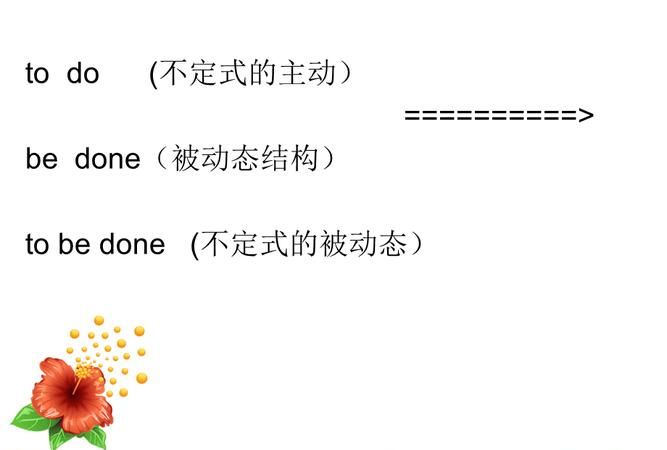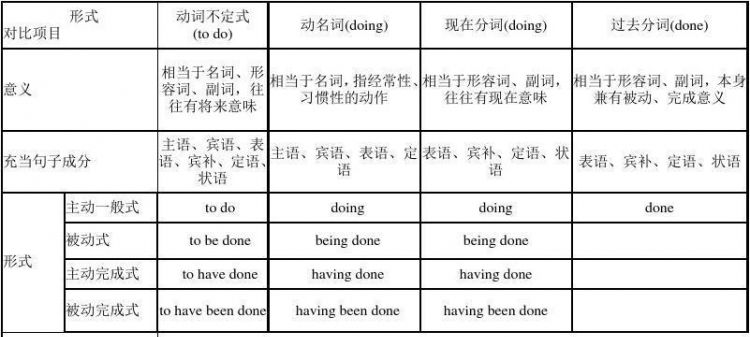本文目录
不定式后面加动词原形吗?
不定式就是动词原型。它是动词的名词形式,同时具有动词和名词的作用。它没有人称和数的形式,很像汉语的动词,但汉...

动词不定式是什么
英语中,把“to do(动词原形)”结构叫做动词不定式。其中to作为小品词用,是动词不定式的标志。但在下列情况下,小品词to会被省略掉。
1、在情态动词及助动词后的不定式不带to。例如:
I can do it myself. 我自己干得了。
Will you please close the window?
请你关上窗户,好吗?
He didn’t go home last night. 昨晚,他没有回家。
2、在see,watch,notice,look at, listen to, hear,feel等感官动词的后面作宾语补足语时。例如:
Did you see him come out of the hotel just now? 你刚才看见他从旅馆出来了吗?
I heard her lock the door. 我听见她锁了门。
但是,上述情况只是出现在主动句中,在被动句中必须带上to。例如:
He was noticed to enter the office. 有人看见他进了办公室。
3、在 make,let,have等使役动词之后作宾语补足语时。例如:
She lets us meet her at the bus station. 她要我们去汽车车站接她。
Don’t make the students do so much homework.. 别让学生做那么多的作业。
与感官动词一样,在被动句中的使役动词必须和带to的不定式连用。例如:
I was made to try it again. 有人要我再试一次。
4、在help后作宾语补足语用的不定式前的小品词to,可带,也可不带。例如:
She helped her mother(to)clean the house yesterday afternoon. 昨天下午,她帮助她母亲打扫屋子。
5、had better后的不定式符号to要省略。例如:
We had better start now. 我们最好立即动身。
You had better not talk in class. 你最好别在课堂上说话。
6、would rather/sooner,rather/sooner than 后的不定式符号to要省略。例如:
We would rather/sooner stay at home. 我们宁可呆在家里。
He prefers to drink some water rather/sooner than drink a coffee.他宁可喝些水,也不愿喝一杯咖啡。
7、“Why not …?”结构中,紧随其后的动词不定式不带to。例如:
Why not ask the man over there?
为什么不那边的这个人?
8、当两个或两个以上的不定式连在一起时,只须在第一个不定式前加to,后面的不定式通常省略to。例如:
I want you to stand beside me and hold the stick. 我想要你站在我身边扶住这根棍子。
He told me to finish my homework and(to)hand it in. 他告诉我完成作业并把它交上去。
9、but 和 except跟在“do + anything/nothing/everything”后面时,通常与不带to的不定式连用。例如:
I could do nothing but lie down.我别无选择,只能躺下。
My pet dog does everything except speak. 我的宠物狗除了不能说话以外,什么事都会做。赞同1| 评论

动词不定式的动词是原型吗
简单来说,三个使役动词 let, have, make:都表示“让某人做某事”
比如:let me do it 让我来做. i have/make TOM repair the door. 我让汤姆去修门。
具体的见下(来自百科)
[省to 的动词不定式]
介绍
1) 情态动词 ( 除ought 外,ought to意思是"应该",是情态动词,只有一种形式,后边接动词不定式,to不能省略。ought to没有人称和数的变化,后接动词原形可以表示现在、将来或过去将来,由时间状语或上下文决定。例如: They ought to come tomorrow.他们明天应当来): 2) 使役动词 let, have, make: 3) 感官动词 see, watch, look at, notice , observe, hear, listen to, smell, feel, find 等后作宾补,省略to。 注意:在被动语态中则to 不能省掉。 在使役动词中get除外(get sb. to do sth.) I saw him dance. =He was seen to dance. The boss made them work the whole night. =They were made to work the whole night.

动词不定式后面接原形
不定式指的就是to do结构,do代指动词原型
另外to后有加ing的情况,但这是不叫不定式,这时to就是介词了

以上就是关于动词不定式后跟动词原形 ,不定式后面加动词原形吗?的全部内容,以及动词不定式后跟动词原形 的相关内容,希望能够帮到您。
